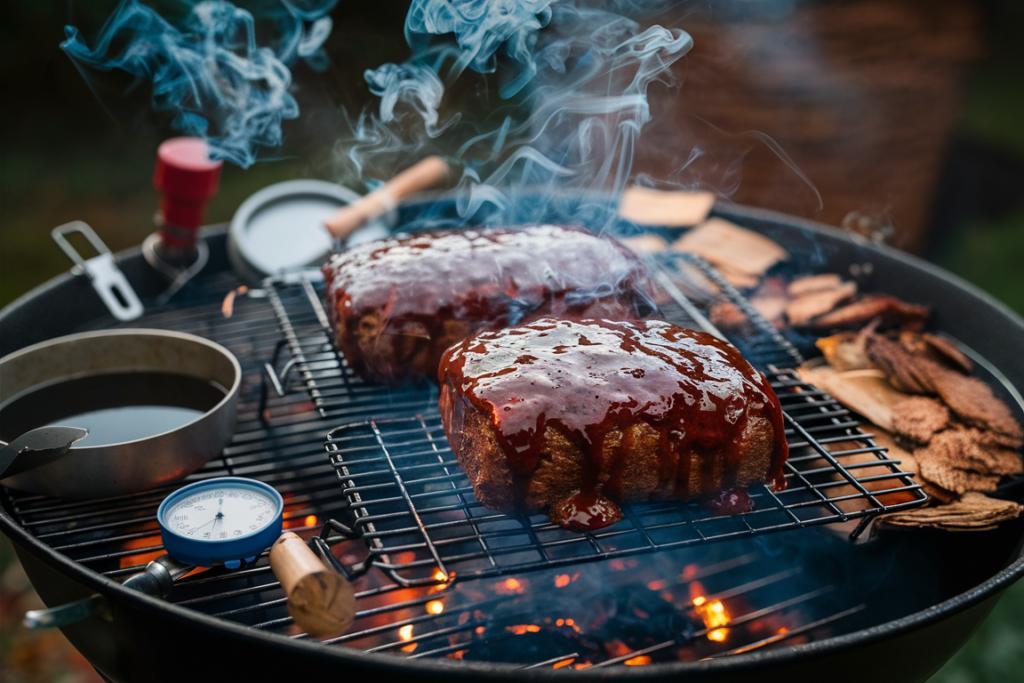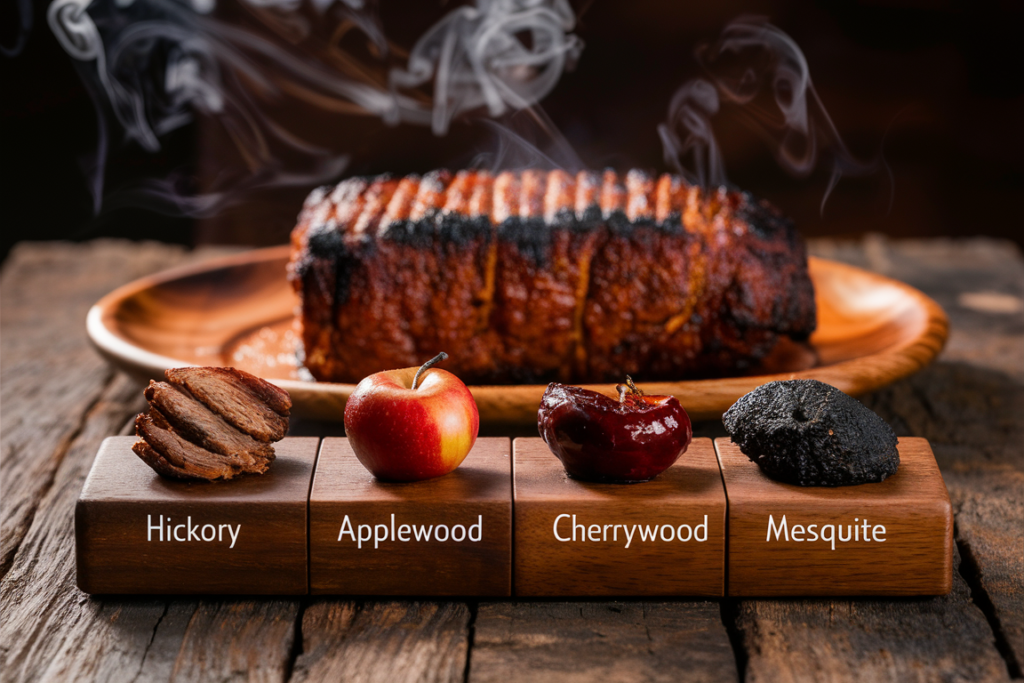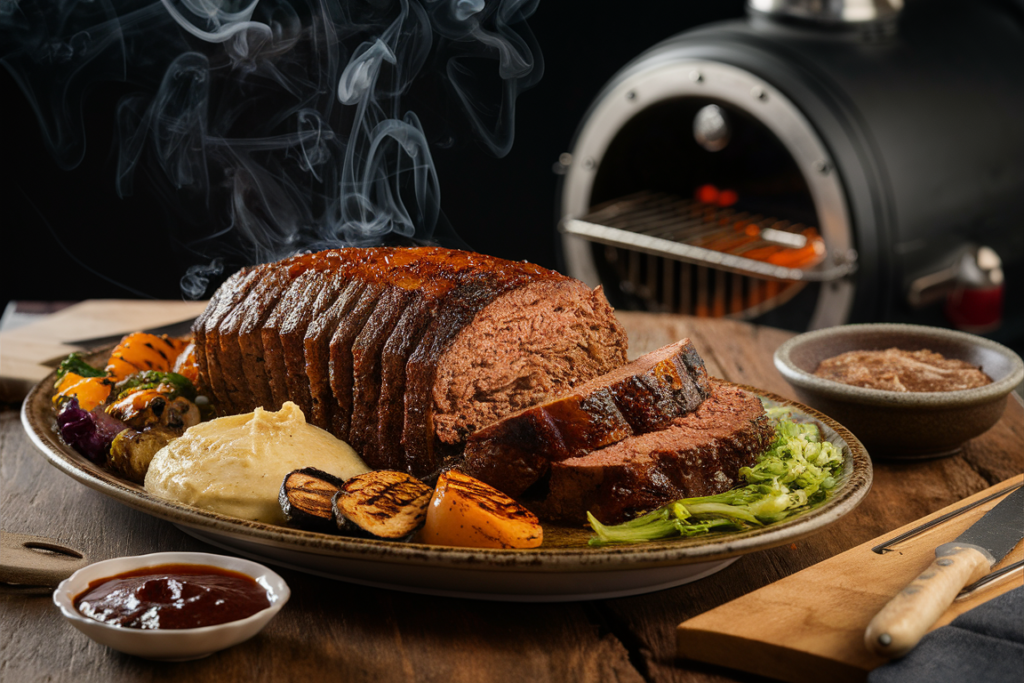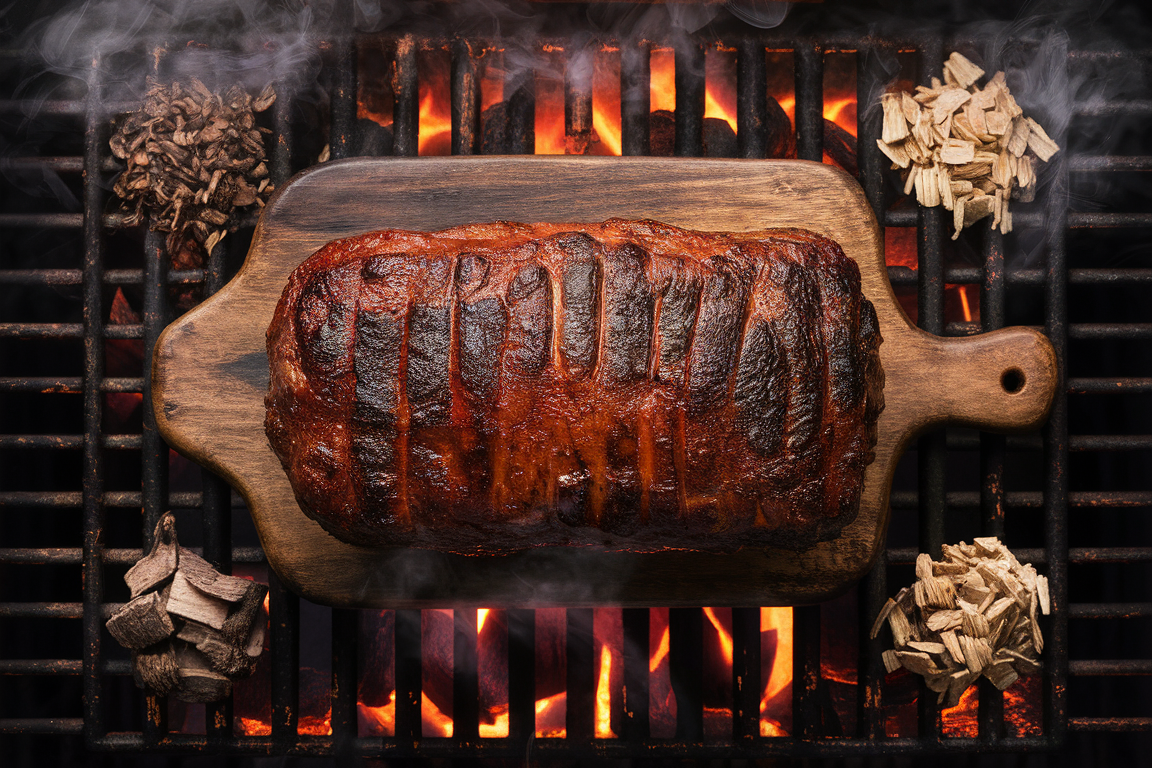Part 1: Introduction and Basics of Smoking Meatloaf
Understanding the Art of Smoking Meatloaf
What Makes Smoked Meatloaf Special?
Smoking meatloaf is an art that transforms this classic comfort dish into a rich and flavorful masterpiece. The key to achieving perfection lies in choosing the best wood to smoke meatloaf. This decision not only influences the depth of flavor but also the texture and aroma of the dish. By using the right smoking techniques and wood types, you can elevate your meatloaf to a whole new level of culinary delight.
A smoked meatloaf combines a tender interior with a slightly caramelized, smoky crust, creating a dish that’s as visually appealing as it is delicious. Let’s explore how the right wood plays a crucial role in this transformation.
The Role of Wood in Smoking Meatloaf
The wood you choose is a critical element when smoking meatloaf. It directly affects the flavor, aroma, and even the appearance of the dish. Different woods provide distinct smoke profiles, ranging from light and fruity to bold and earthy. Selecting the right wood ensures that the smoky flavor enhances, rather than overpowers, the meatloaf’s natural taste. Therefore, understanding wood options is an essential part of mastering this cooking technique.
The Basics of Smoking Meatloaf
What Smoking Does to Meatloaf
Smoking is a slow cooking method that infuses food with deep, smoky flavors while gently cooking it to perfection. For meatloaf, this process does more than just add flavor; it also helps form a slightly caramelized crust that contrasts beautifully with the juicy interior. Additionally, the porous texture of ground meat absorbs smoke more readily, resulting in a rich, smoky taste throughout the dish.
Furthermore, smoking preserves the natural moisture of the meatloaf, provided you use the right techniques. This makes the final product both flavorful and tender—a combination that’s hard to resist.

Key Smoking Techniques for Beginners
If you’re new to smoking, mastering a few basic techniques is essential. First, always preheat your smoker to ensure consistent cooking temperatures. Maintaining a range of 225–250°F is ideal for meatloaf. Second, use indirect heat by positioning the meatloaf away from the direct flame or heat source. This helps prevent burning while allowing the smoke to circulate evenly.
Finally, monitor the smoking process carefully. Avoid opening the smoker frequently, as this can cause heat loss and disrupt the cooking time. Instead, rely on a meat thermometer to check the internal temperature, which should reach 160°F for a fully cooked meatloaf.
Why Choosing the Right Wood Matters
Flavor Impacts
The wood you select determines the type of smoky flavor infused into your meatloaf. For example, fruitwoods like apple and cherry provide a sweet, mild flavor that complements the natural taste of the meat. On the other hand, stronger woods like hickory deliver a bold, earthy smokiness that works well with heavily seasoned meatloaf.
However, using the wrong wood can overpower the dish, leaving it bitter or overly smoky. Thus, it’s important to match the wood’s flavor profile with the seasonings and glaze used in your recipe.
Smoke Intensity and Its Effect on Meatloaf Texture
The intensity of the smoke also plays a crucial role. While light smoke adds a delicate flavor, heavy smoke can alter the texture of the meatloaf, sometimes making it overly dry or tough. Striking the right balance ensures that the dish retains its tenderness while absorbing just the right amount of smokiness.
Common Mistakes When Choosing Smoking Wood
Overpowering Flavors
One of the most common mistakes when smoking meatloaf is using overly strong woods, such as mesquite, without moderation. While bold woods can enhance certain dishes, they can overwhelm the delicate balance of flavors in meatloaf. To avoid this, always start with milder woods and gradually experiment with stronger options.
Incompatible Smoke Profiles
Another mistake is pairing the wrong wood with the meatloaf’s ingredients. For instance, resinous woods like pine or cedar can introduce bitter or medicinal flavors that clash with the dish. Instead, opt for hardwoods known for their food-friendly smoke, such as apple, cherry, or hickory.
Meatloaf Ingredients and Their Role in Flavor Pairing
Meat Blends in Meatloaf
Meatloaf recipes often use a blend of meats, such as beef, pork, or veal. Each of these proteins interacts differently with smoke. For example:
- Beef pairs exceptionally well with bold woods like hickory or oak.
- Pork benefits from sweeter woods like apple or cherry, which enhance its natural flavor.
When choosing a wood, consider the primary protein in your recipe and select a wood that complements it.
Herbs and Seasonings That Complement Smoke
Seasonings play a key role in determining the best wood for your meatloaf. Bold, barbecue-style rubs pair beautifully with stronger woods, while lighter seasonings benefit from mild fruitwoods. For example, Italian-inspired meatloaf with herbs like parsley, oregano, and basil works best with subtle woods like alder or apple.
Preparing Your Smoker for Meatloaf
Different Types of Smokers
Not all smokers are created equal, and choosing the right one can influence your smoking experience. Here’s a quick overview:
- Electric Smokers: Great for beginners, as they offer precise temperature control with minimal effort.
- Charcoal Smokers: Provide an authentic smoky flavor but require more skill to maintain consistent heat.
- Pellet Smokers: Combine the ease of electric models with the rich flavor of charcoal smokers, making them a versatile choice.
Each type of smoker has its benefits, so select one based on your skill level and desired flavor.
Essential Tools for Smoking Meatloaf
To prepare your smoker effectively, you’ll need a few essential tools:
- A high-quality meat thermometer to monitor internal temperatures.
- A water pan to maintain moisture during the smoking process.
- Wood chips, chunks, or pellets that match your desired flavor profile.
By ensuring you have the right tools on hand, you’ll set yourself up for a successful smoking session.
The Science of Smoke and Meatloaf
Smoke Absorption in Ground Meat
Ground meat, such as that used in meatloaf, has a porous texture that absorbs smoke quickly. This makes it an excellent candidate for smoking, as the smoke flavor penetrates deeply into the loaf. However, this also means that over-smoking can occur more easily, so careful monitoring is essential.
How Fat Content Affects Smokiness
The fat content in your meatloaf also impacts how it absorbs smoke. Fats act as carriers for the aromatic compounds in smoke, amplifying its flavor. For this reason, meatloaf with a higher fat content tends to have a richer, more pronounced smokiness.
Understanding Smoke Profiles of Different Woods
Light vs. Heavy Smoke
- Light woods (e.g., apple, cherry): Perfect for beginners; offer a sweet and mild smoke that enhances rather than overpowers.
- Heavy woods (e.g., hickory, mesquite): Better suited for experienced smokers; provide bold flavors but require careful use.
Sweet, Fruity, and Bold Smoke Characteristics
Each wood variety brings its own unique characteristics to the table. For example, sweet woods like apple and cherry add subtlety, while bold woods like hickory create a deep, rich flavor. Understanding these profiles allows you to tailor your smoking process to your preferences.
Quick Tips for Beginners
- Best Starter Woods: Opt for applewood or cherrywood for a mild and versatile flavor.
- Avoiding Over-Smoking: Use a small amount of wood to start, and monitor the smoke closely. A thin, blue smoke is ideal, while thick, white smoke can lead to bitterness.
A Beginner’s Guide to Smoking Temperatures
Ideal Smoking Temperatures for Meatloaf
Maintain a consistent temperature of 225–250°F. This range ensures even cooking and optimal smoke absorption without drying out the meat.
Managing Temperature Fluctuations
To prevent temperature drops or spikes:
- Use a well-insulated smoker.
- Avoid opening the smoker frequently.
- Monitor the temperature with a reliable thermometer.
Part 2: Best Woods for Smoking Meatloaf
Top Woods for Smoking Meatloaf
Characteristics of Ideal Smoking Woods for Meatloaf
Choosing the best wood to smoke meatloaf involves understanding flavor profiles, burn qualities, and compatibility with ingredients. The ideal smoking wood should:
- Burn consistently for even cooking.
- Impart complementary flavors to enhance the meatloaf.
- Be free of resin or chemicals, ensuring a clean smoke.
Fruitwoods for a Sweet and Mild Flavor

Applewood: A Classic Choice
Applewood is a favorite for many smoking enthusiasts because of its mild, sweet flavor. It’s ideal for beginners due to its subtlety, which ensures the smoke doesn’t overpower the meatloaf. Applewood pairs beautifully with pork-based meatloaf or recipes featuring fruity glazes like cranberry or apple sauce.
Cherrywood: Sweetness with a Subtle Tang
Cherrywood offers a similar sweetness to applewood but with a slightly tangy undertone. Its reddish smoke also enhances the visual appeal of the meatloaf, giving it a deep mahogany hue. This wood works well with beef or mixed meatloaves and complements barbecue sauces.
Bold and Strong Options for Meatloaf
Hickory: The All-American Favorite
Hickory is the go-to wood for those who love bold, smoky flavors. Its rich, bacon-like aroma pairs wonderfully with beef and pork meatloaf. However, it’s best used sparingly, as too much hickory smoke can result in bitterness. For a balanced flavor, consider blending hickory with a milder wood like apple.
Mesquite: Bold Flavors for Adventurous Eaters
Mesquite is the strongest of smoking woods, delivering an intense and earthy flavor. While it’s not for everyone, it can create a unique, bold meatloaf when paired with robust seasonings like smoked paprika or chili powder. Use mesquite sparingly to avoid overpowering the dish.
Balancing Flavor with Neutral Woods
Oak: A Well-Rounded Option
Oak is a versatile wood that strikes a perfect balance between mild and bold. It burns steadily, making it ideal for long smoking sessions. Oak’s neutral flavor allows the meatloaf’s spices and glazes to shine, making it a reliable choice for any recipe.
Alder: Subtle and Mild
Alder is a lighter wood known for its gentle smokiness. While commonly used for fish, it’s also an excellent choice for delicate meatloaf recipes, such as turkey or chicken-based versions. Alder allows subtle spices and herbs to take center stage.
Combining Woods for Unique Flavors
Popular Wood Blends
Blending woods allows for more complex flavor profiles. For example:
- Hickory and cherry: A mix of bold and sweet flavors.
- Oak and apple: A balanced blend suitable for most meatloaf recipes.
Pairing Fruitwoods with Strong Woods
Combining fruity and bold woods creates a nuanced smoke profile. Try pairing mesquite with cherry or hickory with apple for a layered smoky taste.
Regional Preferences in Smoking Woods
Southern BBQ Wood Choices
In Southern barbecue traditions, hickory and pecan are staples. Both woods impart rich, smoky flavors that complement meatloaf recipes with bold seasonings or BBQ sauces.
Midwest and Northern Variations
Oak and fruitwoods like apple and cherry are more common in Midwest and Northern regions. These woods offer balanced flavors, perfect for traditional meatloaf with classic herbs like parsley and thyme.
Woods to Avoid for Smoking Meatloaf
Woods with Overpowering or Bitter Flavors
Avoid woods like mesquite unless used sparingly, as their strong profiles can easily dominate the dish. Similarly, eucalyptus or juniper can impart medicinal or bitter notes unsuitable for meatloaf.
Treated or Resinous Woods
Never use woods from conifers like pine or cedar. These woods release resin when burned, producing a harsh, chemical flavor that’s unfit for consumption.
Seasonality and Freshness of Wood
Green vs. Seasoned Wood
- Green wood: Contains high moisture, which produces thick, white smoke that can impart a bitter taste.
- Seasoned wood: Properly dried and aged, it produces clean, flavorful smoke.
Storing Smoking Wood Properly
Store wood in a dry, ventilated area to prevent mold and moisture buildup. Proper storage ensures the wood retains its aromatic qualities.
How Wood Type Affects Smoke Rings
Science Behind Smoke Rings
Smoke rings, the pink layer just below the crust, form when nitrogen dioxide from the smoke reacts with myoglobin in the meat. Certain woods, like hickory or oak, enhance this effect due to their smoke composition.
Woods That Enhance the Smoke Ring
Hardwoods such as oak and hickory produce nitrogen-rich smoke that helps develop a pronounced smoke ring, making your meatloaf visually appealing.
Personalizing Your Meatloaf Smoke
Experimenting with Different Woods
The best way to find your preferred flavor is through experimentation. Try various woods and blends to discover the perfect profile for your taste buds.
Incorporating Herbs and Spices into Wood Chips
For an extra layer of flavor, mix dried herbs like rosemary or thyme with your wood chips. This technique infuses the smoke with aromatic herbal notes, enhancing the overall flavor.
Part 3: Smoking Techniques and Recipes for Meatloaf
Mastering Smoking Techniques for Meatloaf
Setting Up Your Smoker
To achieve the perfect smoked meatloaf, proper smoker setup is essential. Regardless of your smoker type—electric, charcoal, or pellet—ensure the following steps are completed:
- Preheat to 225–250°F: This is the ideal smoking range for meatloaf.
- Add the Right Wood: Use your selected wood chips, chunks, or pellets based on the flavor profile you want to achieve.
- Incorporate a Water Pan: Place a water pan in the smoker to maintain consistent moisture and prevent the meatloaf from drying out.
- Arrange for Indirect Heat: Always cook meatloaf away from direct flames to allow slow, even smoking.
Using Water Pans for Moisture
A water pan does more than keep the meatloaf moist; it also helps regulate the smoker’s internal temperature. Adding aromatics like herbs or citrus to the water can subtly enhance the flavor of the smoke.
Prepping Meatloaf for Smoking
Shaping the Perfect Loaf
Shape your meatloaf compactly to ensure even cooking. Overly thick loaves may take longer to smoke and could result in uneven textures. For consistent results, a standard loaf pan can help create the initial shape.
Adding a Glaze or Rub
- Glaze: A sweet and tangy glaze, such as barbecue sauce or a mixture of ketchup and brown sugar, caramelizes beautifully during smoking.
- Rub: For bolder flavors, coat the meatloaf with a dry rub made of smoked paprika, garlic powder, onion powder, and brown sugar.
Pro Tip: Apply the glaze during the last hour of smoking to prevent burning.
Infusing Wood Flavor into Meatloaf
Using Chips, Chunks, or Pellets
Each form of wood has its advantages:
- Wood Chips: Ideal for shorter smoking sessions; soak them for 30 minutes to extend their burn time.
- Wood Chunks: Burn longer and are better suited for meatloaf, which requires steady smoke for several hours.
- Pellets: Consistent and convenient for pellet smokers, providing an even smoke output.
Timing Your Wood Additions
To avoid over-smoking, start with a small amount of wood and replenish as needed. Monitor the smoke—thin, blue smoke indicates clean burning, while thick, white smoke can impart bitterness.
Temperature and Timing Guide for Smoking Meatloaf
How Long to Smoke Meatloaf
Smoking meatloaf typically takes 2–3 hours at 225–250°F. The exact time depends on the loaf’s size and the consistency of your smoker’s temperature.
Achieving a Perfect Crust
To develop a flavorful crust, allow the glaze or rub to caramelize during the final stages of smoking. Avoid wrapping the meatloaf in foil, as this traps moisture and prevents crust formation.
Recipe Spotlight: Classic Smoked Meatloaf
Ingredients
- 1 lb ground beef
- 1 lb ground pork
- 1 cup breadcrumbs
- 1 egg
- ½ cup milk
- 1 small onion, finely diced
- 2 cloves garlic, minced
- ½ cup barbecue sauce (plus extra for glazing)
- 1 tbsp smoked paprika
- 1 tsp salt
- ½ tsp black pepper
- Wood: Hickory or cherry for a balanced flavor
Step-by-Step Instructions
- Preheat your smoker to 225°F.
- In a large bowl, mix the ground meats, breadcrumbs, egg, milk, onion, garlic, barbecue sauce, and spices until well combined.
- Shape the mixture into a loaf and place it on a smoker-safe pan or rack.
- Place the meatloaf in the smoker and let it cook for 2 hours, maintaining a steady temperature.
- Brush with additional barbecue sauce and smoke for another 30–60 minutes until the internal temperature reaches 160°F.
- Rest for 10 minutes before slicing and serving.
Experimenting with Flavor Profiles
Smoky BBQ Meatloaf
Add a bold BBQ rub to your meatloaf mix, and glaze with a sweet, smoky barbecue sauce during the last hour of cooking. Use hickory or oak for a robust flavor.
Herb-Infused Smoked Meatloaf
Incorporate fresh herbs like rosemary, thyme, and parsley into the meatloaf mix. Pair with a mild wood like apple or alder for a subtle, herbaceous flavor.
Vegetarian and Alternative Meatloaf Options
Smoking Plant-Based Meatloaf
Plant-based alternatives, like lentil or black bean meatloaves, can be smoked for added depth. Use fruitwoods like apple to enhance the natural sweetness of plant-based proteins.
Using Different Proteins
Experiment with turkey, chicken, or even venison meatloaf. Match these proteins with appropriate woods:
- Turkey/Chicken: Apple or cherry for a mild, sweet flavor.
- Venison: Hickory or oak to balance its gamey taste.
Common Challenges and Fixes
Preventing Dryness
- Incorporate moist ingredients like eggs, milk, and breadcrumbs into the meatloaf mix.
- Use a water pan in the smoker.
Avoiding an Over-Smoked Taste
Stick to a moderate amount of wood and monitor smoke levels to avoid a bitter, acrid flavor.
Serving Smoked Meatloaf

Best Side Dishes to Pair
- Creamy mashed potatoes
- Grilled or smoked vegetables
- Coleslaw for a refreshing contrast
- Cornbread for a Southern touch
Presentation Tips
Slice the meatloaf neatly and drizzle with extra glaze or sauce. Garnish with fresh herbs for an added touch of elegance.
Storing and Reheating Smoked Meatloaf
Maintaining Smokiness
Wrap leftovers tightly in foil or plastic wrap and store in the refrigerator for up to 3 days. For longer storage, freeze slices with parchment paper between them.
Ideal Reheating Methods
Reheat in the oven at 300°F, covered with foil to retain moisture. For a crisp crust, remove the foil during the last 10 minutes.
Final Touches for Perfect Smoked Meatloaf
Garnishes and Finishing Sauces
Top your smoked meatloaf with fresh parsley or chives. Offer a selection of sauces, like tangy mustard or smoky barbecue, for added variety.
Carving Techniques
Use a sharp knife to carve the meatloaf into thick, even slices, ensuring the crust stays intact.
FAQs: The Best Wood to Smoke Meatloaf With
- What wood is best for beginners smoking meatloaf?
- Applewood or cherrywood, due to their mild, sweet flavors.
- Can I mix woods when smoking meatloaf?
- Yes! Mixing fruitwoods with bold options like hickory creates complex flavors.
- How do I prevent my meatloaf from drying out?
- Use a water pan, and include moisture-rich ingredients like eggs and milk.
- What’s the best temperature for smoking meatloaf?
- 225–250°F for even cooking and optimal smoke absorption.
- What’s the internal temperature for a fully cooked meatloaf?
- 160°F for ground beef or pork mixtures.
- Can I smoke a vegetarian meatloaf?
- Absolutely. Use apple or alder wood for a subtle, complementary flavor.
- How long should I smoke meatloaf?
- Typically 2–3 hours, depending on the loaf’s size.
- What’s the easiest smoker type for beginners?
- Electric smokers are user-friendly and maintain consistent temperatures.
- What happens if I use too much wood?
- Over-smoking can result in a bitter taste, so start with small amounts.
- Can I use treated or painted wood for smoking?
- No. Only use untreated, food-safe woods to avoid harmful chemicals.

